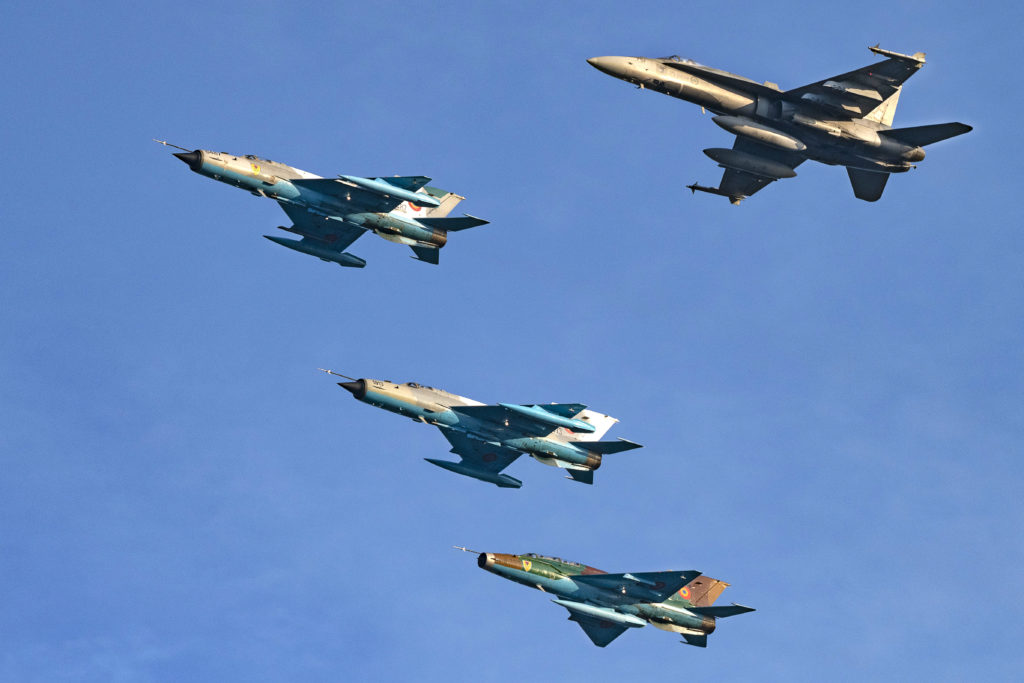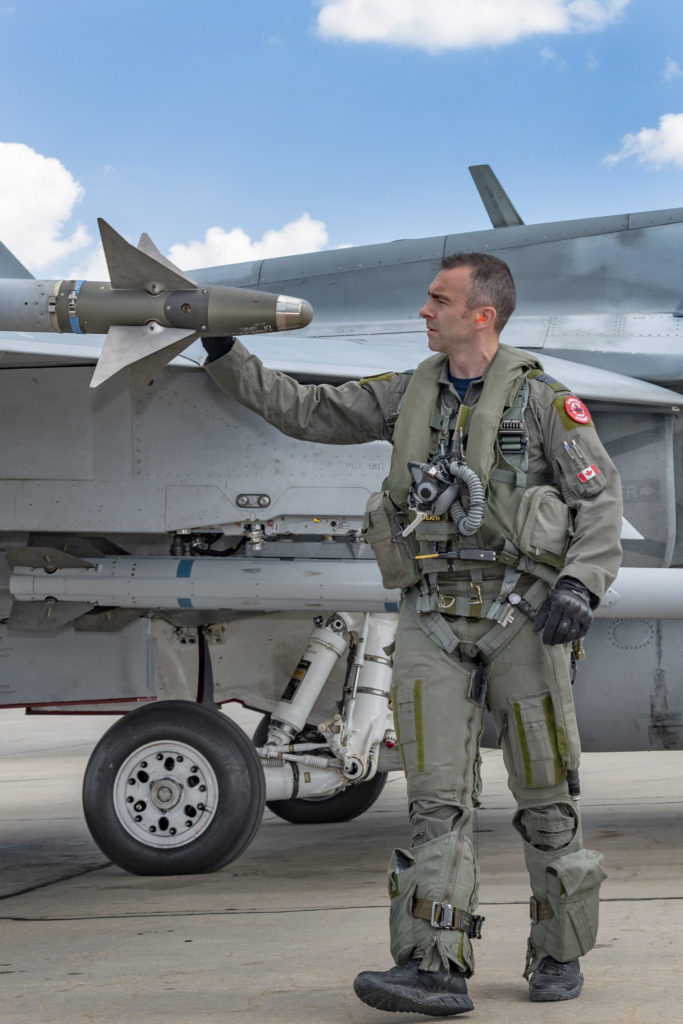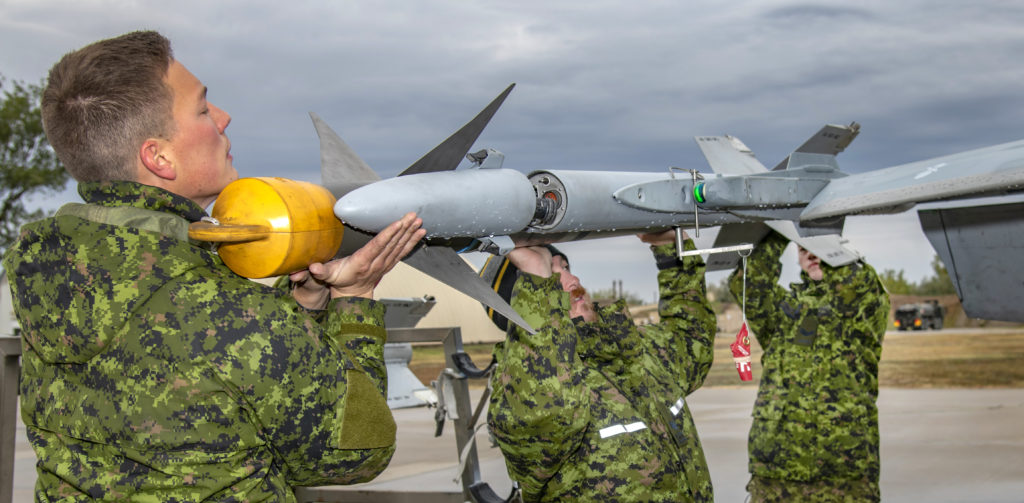Estimated reading time 9 minutes, 36 seconds.
In October 2018, two CF-188 Hornets, one piloted by LCol Tim Woods, intercepted a Russian Su-27 Flanker operating near the western half of the Black Sea.

LCol Forrest Rock has yet to experience a similar encounter, but the commander of the Air Task Force (ATF) currently conducting NATO enhanced air policing and joint training with the Romanian Air Force said Russian aircraft “have kept us busy enough.”
The exact number of scrambles completed by the five Royal Canadian Air Force (RCAF) fighter jets since the mission began on Sept. 1 is classified, but the responses to Russian military flights near Romanian airspace are comparable to previous years, said Rock, commander of 401 Tactical Fighter Squadron at 4 Wing Cold Lake, Alta.
“What I can say is there is a fair amount of activity in and around the Crimean Peninsula, and when they decide to fly west and incur on the Romanian FIR (flight information region), the Romanian and Canadian forces stationed here are postured to respond.”

The quick reaction alert (QRA) duties of NATO enhanced air policing are familiar to RCAF aircrews used to conducting northern sovereignty operations, intercepting tracks of interest encroaching on Canadian airspace.
“There are some differences in terms of how the mission is conducted, but for the pilots it is very similar to what we do back home,” explained Rock. “You will be assigned to the QRA for a period of time — a hot period — and while you are in there, you are on alert. You are in there waiting for the horn to go off.”
The major difference lies in the multinational aspect of air policing, in which the Canadian Hornets and other NATO allied aircraft support and augment Romanian capabilities.
The ATF, comprised of about 135 personnel primarily from 401 Squadron, is part of Operation Reassurance, Canada’s contribution to deterrence and assurance measures in Eastern Europe. While air policing is the main focus, the 2019 mission has invested heavily in multinational training exercises “to validate the processes and procedures that enable NATO to work together to accomplish its objectives,” said Rock.
Training has included trilateral exercises with Bulgaria and Romania, multilateral live fire events with Canadian and U.S. forces in the region, and even air-to-ground engagements with the Canadian-led, nine nation battlegroup in Latvia. “We have committed approximately 70 per cent of our non-alert flying to multinational joint training,” he said.

The ATF also provided the air component for the Canadian Army live control phase of the basic joint terminal attack controller (JTAC) course, held in Romania, “deploying with a fair amount of ground weapons” to support training at a local range.
JTAC training and live fire exercises are often a normal part of the squadron’s routine at home, but the new environment requires “the pilots to examine the different restrictions that apply, operate in a different range, with foreign control agencies. Overall, the exercises present decent opportunities to build experience within the task force,” said Rock.
Building operational experience
The interception of the Su-27 by the commander of the ATF in 2018 was in part a result of the pilot shortage within the RCAF fighter community, which required him to fly more frequently than a commander normally might. For 2019, the ATF includes additional pilots, primarily to fill headquarters roles, but also to step into the cockpit if necessary.
“Having the additional pilots has enabled us to more evenly distribute the load,” explained Rock. “I have flown a fair amount and so have the other pilots that are here in more of a staff capacity. This has allowed us to support all of the activities we have completed and, importantly, has enabled us to build operational experience.”

In fact, he added, “We have just about flown our total mission allocated flying hours, so we are requesting more.”
Another lesson carried over from the 2018 mission is the addition of a fifth CF-188 to ensure availability should one break down or to manage any delays in the shipment of parts from Canada. “This being the third iteration of the task force, I think a lot of the frustrations they experienced in 2017 and 2018 have been ironed out,” noted Rock. “At this point, it is actually a fairly efficient process to bring parts and supplies over. That said, it still does take time, so occasionally you do have an airplane that is down for an extended period. But it hasn’t been something that we haven’t been able to manage.”
Like all Canadian Armed Forces units deployed on Op Reassurance, the ATF faces a persistent barrage of Russian social media that aims to undermine and discredit its capability and intentions. The narrative is often related to a specific event or an incident within NATO forces on which the Russians attempt to capitalize. Rock has borrowed from the playbook of his predecessors, emphasizing to the unit “that proper conduct and smart social media use prevents them the opportunity to undermine or discredit the mission.”

What began in 2014 as a training mission with the Romanian Air Force has evolved with each rotation of the ATF into a partnership and exchange of information on tactics, techniques and procedures related to QRA duty in a NATO context. “We really enjoy flying with the Romanians,” said Rock, noting that the ATF has experienced increased flying with the Romanian MiG-21 Lancers and F-16 Falcons, the latter acquired from Portugal in 2013.
One of the features of the relationship is the ATF’s outreach program, which has contributed significantly to the local community, helping a local orphanage with infrastructure projects to improve its facilities, and support for an autism centre in the city of Constanta. “It has been a really rewarding experience for the task force,” said Rock.
The current mission concludes on Jan. 1, 2020, but the ongoing lessons will be transferred to the next ATF commander who will lead a rotation in the fall of 2020.









Dang I look good